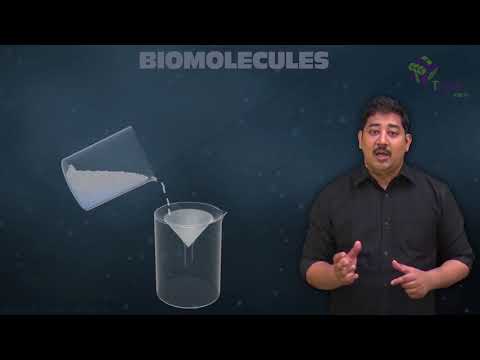Class 12 chemistry MCQs with answers are provided here for chapter 14 Biomolecules. These MCQs are based on the CBSE board curriculum and correspond to the most recent Class 12 chemistry syllabus. By practising these Class 12 Multiple choice questions, students will be able to quickly review all of the ideas covered in the chapter and prepare for the Class 12 Annual examinations as well as other entrance exams such as NEET and JEE.
Download Chapter 14 Biomolecules MCQs PDF by clicking on the button below.
Download PDF
Class 12 Biomolecules MCQs
1. A disaccharide is formed when two monosaccharides are bonded together by a bond.
a) glycosidic
b) peptide
c) ionic
d) phosphodiester
Answer: a
Explanation: When two monosaccharide units come together, they lose a molecule of water and form an oxide bond. The glycosidic linkage is a bond formed by an oxygen atom between two monosaccharide molecules.
2. Sucrose is a _____ chemical, and the hydrolysis product combination is ______in nature.
a) dextrorotatory; dextrorotatory
b) laevorotatory; laevorotatory
c) laevorotatory; dextrorotatory
d) dextrorotatory; laevorotatory
Answer: d
Explanation: Sucrose is a dextrorotatory sugar that produces a combination of dextrorotatory glucose and laevorotatory fructose when hydrolyzed. The resultant mixture is laevorotatory because the specific rotation of fructose is larger than that of glucose.
3. Which of the following statements about maltose is incorrect?
a) It consists of two glucopyranose units
b) It is a disaccharide
c) Glycosidic bond between C1 of one unit and C4 of the other unit
d) It is a non-reducing sugar
Answer: d
Explanation: The free aldehyde group, which has reducing capabilities, can be formed at the C1 carbon of the second -D-glucose unit in solution. As a result, it decreases sugar.
4. Which of the following statements about starch is incorrect?
a) It gives blue colour with iodine
b) It is a polymer of α-D-glucose
c) It is a reducing carbohydrate
d) It consists of branched chains
Answer: c
Explanation: Because it does not decrease Fehling’s solution or Tollen’s reagent, starch is a non-reducing saccharide. This means that all hemiacetal hydroxyl groups of glucose units are linked by glycosidic bonds and are not free.
5. RNA lacks the nitrogen base of _______
a) Thymine
b) Cytosine
c) Uracil
d) Adenine
Answer: a
Explanation: RNA contains the pyrimidine Uracil, whereas DNA contains Thymine. In RNA, Adenine forms two hydrogen bonds with Uracil, but in DNA, Adenine forms two hydrogen bonds with Thymine.
6. Lysine is an example of a polar but uncharged amino acid,
a) Serine
b) Aspartate
c) Lysine
d) Arginine
Answer: a
Explanation: The amino acids Lysine and Arginine are polar and positively charged. Aspartate, on the other hand, is a polar and negatively charged amino acid. Serine is an uncharged, polar amino acid.
7. Which of the following chemical classes does not belong to the vast group of carbohydrates?
a) Polyhydroxy ketones
b) Polyhalo aldehydes
c) Polyamino aldehydes
d) Polyhydroxy carboxylic acids
Answer: a
Explanation: The OH group is absent from polyamino and polyhalo aldehydes. There is no CHO or keto group in polyhydroxy carboxylic acids. When they are hydrolyzed, they do not form OH substituted compounds.
8. Which of the following statements about metabolism is false?
a) It is due to this process that biomolecules do not have a turnover
b) It involves the formation of biomolecules
c) It involves the breaking down of biomolecules
d) It involves various chemical reactions
Answer: a
Explanation: Metabolism entails the breakdown of biomolecules as well as the creation of new ones. It entails a number of chemical processes. It is in charge of the biomolecule turnover.
9. How can we make an amine from an amino acid?
a) Addition of carbon dioxide
b) Removal of ammonia
c) Addition of ammonia
d) Removal of carbon dioxide
Answer: d
Explanation: The elimination of a molecule of carbon dioxide transforms an amino acid into an amine. This is an example of a metabolic reaction that involves the conversion of one biomolecule into another.
10. When converting a disaccharide to monosaccharides, which bond is hydrolyzed?
a) Disulfide bond
b) Glycosidic bond
c) Phosphodiester bond
d) Hydrogen bond
Answer: b
Explanation: A disaccharide is a molecule that consists of two monosaccharides joined by a glycosidic bond. The disaccharide’s glycosidic bond is hydrolyzed to release the constituent monosaccharides.
Recommended Videos
Biomolecules in Living Organisms


Comments